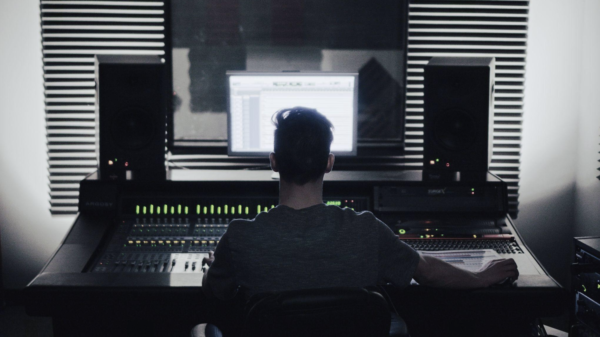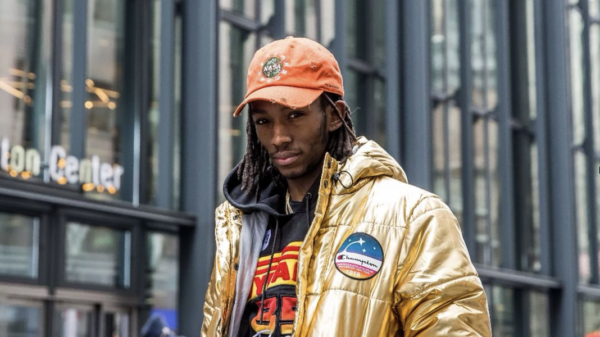In 2010, the estate of the late rapper Big L, who died in 1999, released the album Return of the Devil’s Son posthumously. Donald Phinazee, the rapper’s brother, oversaw the project, stitching the Harlem MC’s demo tracks, unreleased material and freestyles to new production. But the music wasn’t officially licensed, and in 2021 Mike “Heron” Herard, a veteran A&R who became head of the rapper’s estate in 2018, took the album down. Herard then got to work on “Harlem’s Finest: The Return of the King,” which drops today as the latest addition to Mass Appeal’s “Legend Has It…” series highlighting rap veterans.
“We took the best of Devil’s Son, and we got the best freestyles that we could and we put ’em together,” says Herard, a VP of A&R for Shady Records who oversaw the creation of Big L’s first posthumous album, 1999’s The Big Picture. “I’s like an anthology of Big L, one [song from] pre-Diggin’ In The Crates (D.I.T.C.), and then D.I.T.C. years, and some from the after D.I.T.C. years.” D.I.T.C. is a Harlem-based rap collective comprised of Big L, Fat Joe, Lord Finesse, Diamond D, O.C., Buckwild, Showbiz, A.G. and the late Party Arty.
On the 16-track “Return of the King,” Big L’s verses are paired with new features from contemporaries like Nas and Method Man, as well as bars from newcomers like Joey Badass and Errol Holden — and a much-discussed posthumous verse from Mac Miller on “Forever.” There’s also a retouch of his classic Stretch Armstrong and Bobbito Show freestyle with Jay-Z. The project is executive produced by Big L’s estate and co–associate produced by Herard and Royce da 5’9”, who gave creative direction throughout the process, specifically to make sure L’s vocals were locked with the production.
Together, the collective is proud to have crafted a project for a figure whom Herard calls “our Charlie Parker” in the hip-hop community. Both Big L and the jazz great Parker were phenoms who died young; Coleman was murdered at 24, while Parker died of lobar pneumonia at 34. But the resonance of their catalogs has garnered peer respect and a generations-spanning cult following. Big L’s sparse catalog and relative lack of commercial success pale in comparison to generational counterparts like Jay-Z, Nas and Biggie, but Herard and Royce speak for many by asserting that he should be discussed among the best lyricists of all time.
Editor’s picks
“As far as straight-up rapping, I don’t think I heard anybody better skill-wise for that time,” Royce proclaims. “What he was able to do: complex punchlines, using complex syllables, the way he set up his punchlines, no filler in the verses, bursting with personality. Humor… never says anything corny. He’s just good, man. He’s really, really good.” That’s why they crafted a project they hope will impart his talent to new generations.
The process took seven to eight years and started with ensuring that Big L’s rights were properly accounted for. Herard says he went to “distributors, labels, and whoever,” and informed them that L’s estate is the proper rights holder and beneficiary of the music they used for the project. The COVID-19 pandemic created a logjam of cases that delayed the process, but everything was eventually settled. At some point in the 2010s, Phinazee sold the rights to L’s “The Danger Zone” and “The Big Picture” albums, as well as his rhymebooks, to RBC Records co-owner Brian Shafton. But everything else, including freestyles, is now under the estate’s care. “If it’s out there and [Big L] didn’t sign an agreement, it belongs to the estate,” Herard says. His publishing has since been reassigned to what Herard calls an “admin company,” which is properly serving the estate.
As Big L’s rights were gradually secured, Herard, who produced “Flamboyant” on The Big Picture, was able to think more creatively. He got at least four a cappellas from people close to L: his D.I.T.C. comrade Showbiz; DJs Ron G and Tony Touch, whom he recorded freestyles for; and Rich King, with whom L co-founded his label Flamboyant Entertainment. Herard also had producers turn some of Big L’s most iconic freestyles into a cappellas that were reworked for “Return of the King.” The remake of Big L and Jay-Z’s iconic “7-Minute Freestyle” on “The Stretch Armstrong and Bobbito Show” sounds close to the original. But Big L’s “Stretch & Bob Freestyle (’98)” trades the beat from Pitch Black’s “Show and Prove” for eerie strings, while the album’s take on his “Sandman 118” freestyle — on “RHN (Real Harlem Niggas)” — maintains the gloomy energy of the original Isaac Hayes–sampling track with added keys and synths.
Related Content
The Estate of Big L
Almost every track on the album started with a Big L a cappella placed over drums. Herard would then send the frame to Royce to ensure that vocals were in pocket before tasking producers to add instrumentation. Herard previously told Rolling Stone that Big L and Nas’ “U Ain’t Gotta Chance,” the album’s first single, was a six-step production process between seven people, and other junctures of the project were similarly layered. According to Herard, the vision for the soundscape was “that ’90s feel just a hair elevated with the mix.” That aesthetic is reflected in tracks like the velvety “Grants Tomb ’97 (JazzMobile),” featuring Joey Badass and up-and-coming artist Bvngs, “Fred Samuel Playground” with Method Man, and “Forever” with the late Mac Miller, who died in 2018.
In a statement, Mac Miller’s estate tells Rolling Stone, “We have been incredibly protective of how any of Malcolm’s music has been released over the past 7 years, and this opportunity was no different as it represents a unique opportunity to unite his vocals with one of his all-time favorite musicians. As Mac Miller fans will already know, Malcolm regularly cited Big L as the rapper that first inspired him to pick up the pen and try his hand at the genre.”
Herard says the song with Miller came together after a chance discussion between him and DJ Critical Hype, who told him he had a verse from the late Pittsburgh artist’s estate. When the posthumous collaboration was announced, some fans said it felt like an opportunistic pairing of two artists who had never met, but both Herard and Royce feel like it was a fated connection. “Our paths were aligned, our spirits were aligned. [We were both] like, ‘Yo, I want the best for my guy. Let’s make this work,’” Herard says of him and DJ Critical. Herard says he found a beat matching Miller’s vocals within 30 minutes of receiving them. Royce adds, “When shit just falls into place like that, that lets you know it’s meant to be.”
Others would beg to differ; posthumous projects are polarizing. Tyler, the Creator summed up a popular sentiment toward them while telling concertgoers at an L.A. show that he blocked the possibility of posthumous projects in his will. He scoffed that they’re “fucking gross, like, half-ass ideas and some random feature on it from some nigga I didn’t fuck with. Like, no.” In place of an artist’s creative intent, these projects hinge entirely on the discernment and dedication of whoever stewards them. That means they could be crafted by the artist’s right-hand men — like Mobb Deep’s Infinite, where Prodigy’s longtime music partners Havoc and the Alchemist gave their all to a fitting send-off to the Infamous group. But some of these albums have also been helmed by profit-driven executives with minimal musical instincts; those are the projects that fuel the perception that they’re invasive money grabs.
Ultimately, posthumous albums aren’t going anywhere. So, unless someone decides to boycott everything not released by a living artist, they’re best evaluated on a case-by-case basis. Both Herard and Royce say they’re aware of the skepticism around the project and posthumous albums in general, but Royce has a simple retort.
“I understand the concern of people, but I think that only applies when it’s bad,” Royce says. “None of these verses were throwaways; you literally are talking about somebody who’s never recorded a bad verse. So in that regard, it’s very, very easy. It’s some concerns on one end, but it’s an extreme upside on the other end. We got to think about his family. We know he would want his name to live on. His life got tragically stopped way too soon.”
Herard concurs, revealing that his creative approach transcended that of an album curator: “This is provenance and restoration. This happens in fine art. Sometimes they find a piece of art and they need an art restorer to bring it back to life. That guy doesn’t touch a brush sometimes [for] months, a year, because every brush stroke, the paint, the weather where it was done, where was it done; all of that research gets done before he touches the canvas. That’s what we did here.”
He also notes that the project will provide funds for L’s family. “Now fucking YouTube and whoever posted [a song] aren’t the ones getting paid,” Herard says. “The people, his heirs, are now earning from it. So there’s a couple of tiers to this: You’re restoring ownership and you’re reigniting cultural relevance.” Along with the album, Herard is overseeing Big L merch (including an upcoming AWAKE collaboration) and a documentary crafted from footage recorded by Thomas Ferrara, who Herard says “used to walk around filming [Big L] all day.” They’re aiming for the doc to be completed in time for the 2026 Tribeca Film Festival. “You see what I just did? I put it in the Universe,” Herard jokes with Royce.
The two bounce off each other seamlessly throughout our conversation. Royce says that while Herard was A&R of Slaughterhouse, the supergroup that included Royce, Joe Budden, Crooked I, and Joell Ortiz, the two would often be the last in the studio, “throwing ideas around and finishing records.” But the day’s conversation is their first time verbally communicating in a year.
Royce revealed that for the past several years he’s been dealing with lingual dystonia, a neurological condition where, he says, “there’s some kind of interruption in the nerve firing off in my tongue,” causing spasms that hindered him from talking and recording music.
Trending Stories
“My cranial nerves and my vagus nerve were all inflamed. I got a genetic condition called the COMT gene that processes dopamine slower than normal,” he exaplins. “And when I did a neurochemistry test, [I found out] the left hemisphere of my brain produces less dopamine than the right. So not only is it less dopamine, but it’s an imbalance as well. When your dopamine is low, that’s like Parkinson’s, ADHD… I had involuntary movements in my face and in my tongue. So they went on this long thing where they would put me on all these different kinds of medicines.” He says he went through several improper diagnoses, but he’s “almost through it,” and has started recording again. “I wish I was recording when we were doing this album,” he says.
Even without his verse on the project, Royce helped craft an album that he and Herard are proud of. After almost an hour of detailing the tedious project of crafting “Return of the King,” Herard says he wants more artists to prioritize their affairs to prevent some of the headaches that Big L’s family has gone through. “I want everybody who’s an artist that reads this to get a trust,” he says. “I want them to get life insurance policies, and I want them to have a will. That’s what I want for you. And I love you.”




























